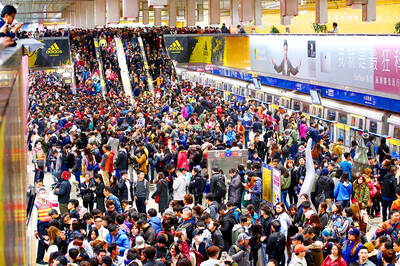Food watchdogs and a lawmaker yesterday accused the government of failing to test the residue level of glyphosate in soybeans, despite the nation having the strictest maximum residue limits for glyphosate.
Glyphosate, an herbicide developed by leading genetically modified seed producer Monsanto, is widely used in the US and South America, where soybeans that have been genetically modified to tolerate the glyphosate herbicide are grown.
Taiwan imports about 2.4 million tonnes of soybeans annually, or about 99.95 percent of the soybeans used in the country, with 55 percent of the annual import coming from the US and the rest from South America, said Warren Kuo (郭華仁), a professor of agronomy at National Taiwan University.
According to a press statement released by the Council of Agriculture earlier this year, 28,000 tonnes, or 12 percent of the total imported soybeans, are used directly in food products such as tofu or soy milk, and 75 percent, or 1.8 million tonnes, are used to make cooking oil.
About 90 percent of imported soybeans are genetically modified (GM), and four of the 12 GM soybean strains that Taiwan has approved for import are glyphosate-resistant.
“Taiwan has a maximum residue limit [MRL] for glyphosate of 10 parts per million [ppm], which is lower than that of the US, Japan and the Codex Alimentarius at 20ppm,” Democratic Progressive Party Legislator Lin Shu-fen (林淑芬) told a press conference held with the Homemakers United Foundation and the Green Formosa Front.
“However, the problem is that what we have been using for testing is the ‘multi-residue analysis,’ which analyzes the residue levels of 251 pesticides at one time, and glyphosate is not one of them,” Lin said.
When Lin asked the authorities and labs whether it is possible to test residue level for glyphosate alone, she said the answer she got was that “the method is still under development.”
Kuo added that a research study published in Germany last week found surprisingly high residue levels of glyphosate in soybean crops, some with levels as high as 90ppm, grown in Argentina, from where Taiwan has been importing soybeans for years.
Glyphosate has been said to “incur no immediate health risk,” but studies have found that the chemical affects healthy gut bacteria and deactivates the liver enzymes, Kuo said.
As Taiwanese consume a large amount of soybeans and soybean-based products, the group said the government should aim for a higher soybean self-sufficiency rate in Taiwan, more effective custom checks on herbicide residues and clear labels separating non-GM, food-grade soybeans from those that are not.

People can take the Taipei MRT free of charge if they access it at Nanjing Sanmin Station or Taipei Arena Station on the Green Line between 12am and 6am on Jan. 1, the Taipei Department of Transportation said on Friday, outlining its plans to ease crowding during New Year’s events in the capital. More than 200,000 people are expected to attend New Year’s Eve events in Taipei, with singer A-mei (張惠妹) performing at the Taipei Dome and the city government’s New Year’s Eve party at Taipei City Hall Plaza, the department said. As people have tended to use the MRT’s Blue or

Civil society groups yesterday protested outside the Legislative Yuan, decrying Chinese Nationalist Party (KMT) efforts to pass three major bills that they said would seriously harm Taiwan’s democracy, and called to oust KMT caucus whip Fu Kun-chi (傅?萁). It was the second night of the three-day “Bluebird wintertime action” protests in Taipei, with organizers announcing that 8,000 people attended. Organized by Taiwan Citizen Front, the Economic Democracy Union (EDU) and a coalition of civil groups, about 6,000 people began a demonstration in front of KMT party headquarters in Taipei on Wednesday, organizers said. For the third day, the organizers asked people to assemble

Taipei is participating in Osaka’s Festival of Lights this year, with a 3m-tall bubble tea light installation symbolizing Taiwan’s bubble tea culture. The installation is designed as a bubble tea cup and features illustrations of Taipei’s iconic landmarks, such as Taipei 101, the Red House and North Gate, as well as soup dumplings and the matchmaking deity the Old Man Under the Moon (月下老人), affectionately known as Yue Lao (月老). Taipei and Osaka have collaborated closely on tourism and culture since Taipei first participated in the festival in 2018, the Taipei City Department of Information and Tourism said. In February, Osaka represented

Taiwanese professional baseball should update sports stadiums and boost engagement to enhance fans’ experience, Chinese Professional Baseball League (CPBL) commissioner Tsai Chi-chang (蔡其昌) told the Liberty Times (sister paper of the Taipei Times) in an interview on Friday. The league has urged Farglory Group and the Taipei City Government to improve the Taipei Dome’s outdated equipment, including relatively rudimentary television and sound systems, and poor technology, he said. The Tokyo Dome has markedly better television and sound systems, despite being 30 years old, because its managers continually upgraded its equipment, Tsai said. In contrast, the Taipei Dome lacked even a room for referees